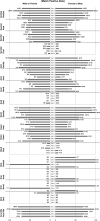Concordance and transmission of human papillomavirus within heterosexual couples observed over short intervals
- PMID: 23319742
- PMCID: PMC3603534
- DOI: 10.1093/infdis/jit018
Concordance and transmission of human papillomavirus within heterosexual couples observed over short intervals
Abstract
Background: Because many human papillomavirus (HPV) infections are transient, rates of transmission may be miscalculated if the interval between testing spans several months. We examined rates of concordance and transmission in heterosexual couples over short intervals.
Methods: Twenty-five adult couples were enrolled and sampled for HPV DNA from the genitals, hand, and mouth 5 times over a 6-week period, including 24 hours after sexual intercourse and after 48 hours of abstinence. Concordance and transmission patterns were described.
Results: Concordance between the couple's genital sites ranged from 64% to 95% for at least 1 HPV type. The highest rates of concordance were observed 24 hours after sexual intercourse. A similar peak in concordance was not seen between genital and nongenital anatomic sites. Transmission rates for female genital to male genital ranged from 26.8 to 187.5 per 100 person-months and for male genital to female genital from 14.5 to 100 per 100 person-months.
Conclusions: High rates of concordance shortly after intercourse suggest that some DNA detections in the genital area are contaminants from a partner and not established HPV infections. Female-to-male transmission appeared more common than male-to-female transmission.
Figures


References
-
- Burchell AN, Winer RL, de Sanjose S, Franco EL. Chapter 6: Epidemiology and transmission dynamics of genital HPV infection. Vaccine. 2006;24(Suppl 3):S3/52–61. - PubMed
Publication types
MeSH terms
Substances
Grants and funding
LinkOut - more resources
Full Text Sources
Other Literature Sources
Medical

